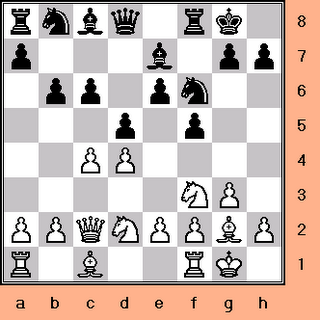Chess: Understanding the Dutch Defense (Stonewall Variation) Part I
1 d4 f5 2 c4 e6 3 Nf3 Nf6 4 g3 Be7 5 Bg2 0-0
6 0-0 d5 Line

What’s the game plan for White?
White intends to attack Black’s queenside via
c5/cxd5 followed by the maneuvers b2-b4-b5/
a2-a4-a5. Please observe how the g2 bishop
is ideally placed to assist in this assault.
In the center, he wants to break through with
e2-e4. However, he needs to prepare for it by
transferring the f3 knight to d3 followed by
f2-f3.

What’s the game plan for Black?
Black, on the other hand, plans to assail
White’s kingside by way of … Nf6-e4, ... g5,
... Qe8 and ... Qh5. However, if White preludes
his queenside attack with c5 instead of cxd5,
Black should give preference to the counter-
thrust ... e5. Please bear in mind that the
"bad" c8 bishop could become a liability in
the endgame. That’s why a third plan is to
develop it via ... b6, ... Bb7 and ... c5.
Another weakness in Black’s position is e5.
White therefore frequently plays Bf4, keeping
the square under observation and preventing
... e6-e5.
Also available:
Understanding the Dutch Defense
(Staunton Gambit)
http://chesscoach1950.blogspot.com/2006/06/chess-understanding-dutch-defense.html
1 d4

1 ... f5

Black immediately assumes control of the e4 square.
2 c4

2 e4
2 g3
2 Nf3
2 Nc3
2 Bg5
2 Bf4
2 c3
2 g4
2 h3
2 b3
2 Nh3
2 e3
2 h4
2 ... e6

2 ... Nf6
2 ... d6
2 ... g6
2 ... c6
3 Nf3

3 g3
3 Nc3
3 e3
3 g4
3 ... Nf6

3 ... d5
3 ... Bb4+
4 g3

4 Nc3
4 e3
4 Bg5
4 Bf4
4 a3
4 ... Be7

4 ... d5
4 ... c6
4 ... d6
4 ... Bb4+
4 ... b6
5 Bg2

5 Nc3
5 d5
5 ... 0-0

5 ... d5
5 ... d6
5 ... c6
6 0-0

6 Nc3
6 d5
6 ... d5

6 ... d6
6 ... Ne4
6 ... c6
6 ... Qe8
7 Nbd2

7 b3
7 Qc2
7 Nc3
7 Bg5
7 Ne5
7 ... c6

7 ... Nc6
7 ... b6
7 ... a5
8 Qc2

8 Ne5
8 b3
8 ... b6

8 ... a5
8 ... Qe8
8 ... Ne4
8 ... Bd7
9 Ne5

9 b3
9 ... Bb7

10 Ndf3

10 Nd3
10 ... Ne4

11 Nd3

11 b3
11 ... Bf6

11 ... Bd6
12 Bf4

12 ... Nd7

13 cxd5

13 ... exd5

14 Nfe5

14 ... Rc8

15 Rfc1

15 ... Nxe5

16 Bxe5

16 ... Qe7

By ChessCoach@care2.com
6 0-0 d5 Line

What’s the game plan for White?
White intends to attack Black’s queenside via
c5/cxd5 followed by the maneuvers b2-b4-b5/
a2-a4-a5. Please observe how the g2 bishop
is ideally placed to assist in this assault.
In the center, he wants to break through with
e2-e4. However, he needs to prepare for it by
transferring the f3 knight to d3 followed by
f2-f3.

What’s the game plan for Black?
Black, on the other hand, plans to assail
White’s kingside by way of … Nf6-e4, ... g5,
... Qe8 and ... Qh5. However, if White preludes
his queenside attack with c5 instead of cxd5,
Black should give preference to the counter-
thrust ... e5. Please bear in mind that the
"bad" c8 bishop could become a liability in
the endgame. That’s why a third plan is to
develop it via ... b6, ... Bb7 and ... c5.
Another weakness in Black’s position is e5.
White therefore frequently plays Bf4, keeping
the square under observation and preventing
... e6-e5.
Also available:
Understanding the Dutch Defense
(Staunton Gambit)
http://chesscoach1950.blogspot.com/2006/06/chess-understanding-dutch-defense.html
1 d4

1 ... f5

Black immediately assumes control of the e4 square.
2 c4

2 e4
2 g3
2 Nf3
2 Nc3
2 Bg5
2 Bf4
2 c3
2 g4
2 h3
2 b3
2 Nh3
2 e3
2 h4
2 ... e6

2 ... Nf6
2 ... d6
2 ... g6
2 ... c6
3 Nf3

3 g3
3 Nc3
3 e3
3 g4
3 ... Nf6

3 ... d5
3 ... Bb4+
4 g3

4 Nc3
4 e3
4 Bg5
4 Bf4
4 a3
4 ... Be7

4 ... d5
4 ... c6
4 ... d6
4 ... Bb4+
4 ... b6
5 Bg2

5 Nc3
5 d5
5 ... 0-0

5 ... d5
5 ... d6
5 ... c6
6 0-0

6 Nc3
6 d5
6 ... d5

6 ... d6
6 ... Ne4
6 ... c6
6 ... Qe8
7 Nbd2

7 b3
7 Qc2
7 Nc3
7 Bg5
7 Ne5
7 ... c6

7 ... Nc6
7 ... b6
7 ... a5
8 Qc2

8 Ne5
8 b3
8 ... b6

8 ... a5
8 ... Qe8
8 ... Ne4
8 ... Bd7
9 Ne5

9 b3
9 ... Bb7

10 Ndf3

10 Nd3
10 ... Ne4

11 Nd3

11 b3
11 ... Bf6

11 ... Bd6
12 Bf4

12 ... Nd7

13 cxd5

13 ... exd5

14 Nfe5

14 ... Rc8

15 Rfc1

15 ... Nxe5

16 Bxe5

16 ... Qe7

By ChessCoach@care2.com
0 Comments:
Post a Comment
<< Home